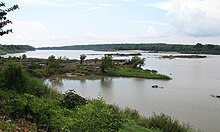The Wordsmith (
talk |
contribs) Reverted 2 edits by
204.81.161.79 to last revision by Markhurd (
HG) |
Malekhanif (
talk |
contribs) No edit summary |
||
| Line 18: | Line 18: | ||
==References== |
==References== |
||
<references /> |
<references /> |
||
==External links== |
|||
* [http://www.un.org/Depts/Cartographic/map/profile/mekong.pdf United Nations map of the region] |
|||
* [http://www.gms-eoc.org/ Greater Mekong Subregion Environment Operations Center] |
|||
* [http://www.aseansec.org/11600.htm A brief history of ASEAN's role in the GMS] |
|||
* [http://www.rockmekong.org/ Thailand's Learning Across Boundaries in the GMS] |
|||
* [http://www.worldwildlife.org/wildplaces/flm/about.cfm World Wildlife Federation's GMS site] |
|||
* [http://japanese.china.org.cn/english/international/234322.htm GMS nations meet to fight human trafficking] |
|||
{{SEAsia-geo-stub}} |
|||
[[Category:Mekong River]] |
|||
[[Category:Regions of Asia]] |
|||
[[vi:Tiểu vùng Sông Mekong Mở rộng]] |
|||
[[zh:大湄公河次区域经济合作]] |
|||
Revision as of 08:43, 23 April 2009

The Greater Mekong Subregion is a geological region that includes nations and territories located in the Mekong River basin, namely Cambodia, Laos, Myanmar, Thailand, Vietnam, and the Yunnan Province of China. The region is considered a significant biodiversity hotspot by Conservation International and the WWF. [1] [2]
Geology and biodiversity
The region has a diverse geographic landscape including massifs, plateaus and limestone karsts, lowlands, fertile floodplains and deltas, forests ( evergreen and semi-evergreen, deciduous, dipterocarp, mangroves, and swamp), and grasslands. Water environments include fast-flowing rocky mountain streams and wetlands (such as Tonlé Sap in Cambodia). [1]
The region's geographic variety and consequent variety of climatic zones supports significant biodiversity, with more than 1068 new species discovered during the last ten years. The geographic region encapsulates 16 of the WWF Global 200 ecoregions, and habitats for an estimated 20000 plant species, 1300 fish species, 1200 bird species, 800 reptile and amphibian species, and 430 mammal species. Notable species include the Javan rhino, Irrawaddy dolphins, and Mekong giant catfish (one of the largest freshwater fish). [1]
The region's biodiversity is ranked as a top-five most threatened hotspot by Conservation International. The WWF cites accelerating economic development, population growth and increased consumption patterns as primary causes, including agricultural deforestation, logging and illegal timber trade, wildlife trade, overfishing, dam and road construction, and mining. The WWF also states that the region is particularly vulnerable to global climate change. [1]
See also
- Greater Mekong Sub-region Academic and Research Network
- GMS Environment Operations Center
- The Journal of GMS Development Studies
- Mekong River
- Mekong Delta
References
The Wordsmith (
talk |
contribs) Reverted 2 edits by
204.81.161.79 to last revision by Markhurd (
HG) |
Malekhanif (
talk |
contribs) No edit summary |
||
| Line 18: | Line 18: | ||
==References== |
==References== |
||
<references /> |
<references /> |
||
==External links== |
|||
* [http://www.un.org/Depts/Cartographic/map/profile/mekong.pdf United Nations map of the region] |
|||
* [http://www.gms-eoc.org/ Greater Mekong Subregion Environment Operations Center] |
|||
* [http://www.aseansec.org/11600.htm A brief history of ASEAN's role in the GMS] |
|||
* [http://www.rockmekong.org/ Thailand's Learning Across Boundaries in the GMS] |
|||
* [http://www.worldwildlife.org/wildplaces/flm/about.cfm World Wildlife Federation's GMS site] |
|||
* [http://japanese.china.org.cn/english/international/234322.htm GMS nations meet to fight human trafficking] |
|||
{{SEAsia-geo-stub}} |
|||
[[Category:Mekong River]] |
|||
[[Category:Regions of Asia]] |
|||
[[vi:Tiểu vùng Sông Mekong Mở rộng]] |
|||
[[zh:大湄公河次区域经济合作]] |
|||
Revision as of 08:43, 23 April 2009

The Greater Mekong Subregion is a geological region that includes nations and territories located in the Mekong River basin, namely Cambodia, Laos, Myanmar, Thailand, Vietnam, and the Yunnan Province of China. The region is considered a significant biodiversity hotspot by Conservation International and the WWF. [1] [2]
Geology and biodiversity
The region has a diverse geographic landscape including massifs, plateaus and limestone karsts, lowlands, fertile floodplains and deltas, forests ( evergreen and semi-evergreen, deciduous, dipterocarp, mangroves, and swamp), and grasslands. Water environments include fast-flowing rocky mountain streams and wetlands (such as Tonlé Sap in Cambodia). [1]
The region's geographic variety and consequent variety of climatic zones supports significant biodiversity, with more than 1068 new species discovered during the last ten years. The geographic region encapsulates 16 of the WWF Global 200 ecoregions, and habitats for an estimated 20000 plant species, 1300 fish species, 1200 bird species, 800 reptile and amphibian species, and 430 mammal species. Notable species include the Javan rhino, Irrawaddy dolphins, and Mekong giant catfish (one of the largest freshwater fish). [1]
The region's biodiversity is ranked as a top-five most threatened hotspot by Conservation International. The WWF cites accelerating economic development, population growth and increased consumption patterns as primary causes, including agricultural deforestation, logging and illegal timber trade, wildlife trade, overfishing, dam and road construction, and mining. The WWF also states that the region is particularly vulnerable to global climate change. [1]
See also
- Greater Mekong Sub-region Academic and Research Network
- GMS Environment Operations Center
- The Journal of GMS Development Studies
- Mekong River
- Mekong Delta